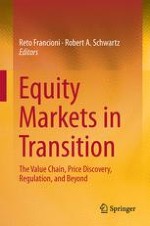2017 | OriginalPaper | Chapter
13. High Frequency Trading: Market Structure Matters
Authors : Reto Francioni, Peter Gomber
Published in: Equity Markets in Transition
Publisher: Springer International Publishing
Activate our intelligent search to find suitable subject content or patents.
Select sections of text to find matching patents with Artificial Intelligence. powered by
Select sections of text to find additional relevant content using AI-assisted search. powered by
